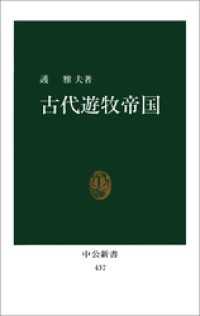- ホーム
- > 洋書
- > 英文書
- > Nature / Ecology
Full Description
Very few studies have been conducted to explore the vulnerability of women in the context of climate change. This book addresses this absence by investigating the structure of women's livelihoods and coping capacity in a disaster vulnerable coastal area of Bangladesh.
The research findings suggest that the distribution of livelihood capitals of vulnerable women in rural Bangladesh is heavily influenced by several climatic events, such as cyclones, floods and seasonal droughts that periodically affect the region. Women face several challenges in their livelihoods, including vulnerability to their income, household assets, lives and health, food security, education, water sources, sanitation and transportation systems, because of ongoing climate change impacts. The findings have important policy relevance for all involved in disaster and risk management, both within Bangladesh and the developing countries facing climate change impacts.
Based on the research findings, the book also provides recommendations to improving the livelihoods of women in the coastal communities. This book will appeal to academics, researchers and professionals in environmental management, gender and development, and climate change governance looking at the effects of and adaptation to climate change, gender issues and natural disaster management strategies.
Contents
1. Introduction 1.1 Background to the study 1.2 Rationale for this book 1.3 Layout of the book References 2. Climate Change Impacts and Women in Bangladesh 2.1 Background information on Bangladesh 2.1.1 Geographical location of Bangladesh 2.1.2 Weather and seasons in Bangladesh 2.1.3 Demography and over-population in Bangladesh 2.1.4 Poverty and inequality in Bangladesh 2.2 Climate change and Bangladesh 2.2.1 Cyclones and storm surges 2.2.2 Sea level rise 2.2.3 Floods and flooding 2.2.4 Salinity 2.2.5 Drought 2.3 The status of women in rural Bangladesh 2.4 Climate change impact on women's livelihood 3. Vulnerability and Sustainable Livelihood Framework: Methodological Considerations 3.1 The Sustainable Livelihood Framework (SLF) 3.1.1 Core concepts of the Sustainable Livelihood Framework 3.1.2 Modelling the Sustainable Livelihoods Framework (SLF) 3.1.3 Application of the Sustainable Livelihood Framework (SLF) around the world and its relevance to this study 3.2 Understanding and assessing vulnerability 3.2.1 Vulnerability assessment 3.2.2 The Disaster Crunch Model 3.2.3 The Livelihood Vulnerability Index (LVI) 3.2.4 LVI-IPCC: IPCC framework approach 3.3 Selection of the study area 3.4 Research design 3.4.1 Data sources 3.4.2 Sampling procedure 3.5 Data collection 3.5.1 Household surveys through personal interviews 3.5.2 Focus group discussion (FGD) 3.5.3 Key informant interviews 3.5.4 Direct observation through a transect walk 3.6 Data Analysis 3.6.1 Quantitative analysis 3.6.1.1Calculation of LVI 3.6.1.2 Calculation of IPCC-LVI 3.6.1.3 Vulnerability spider diagram and vulnerability triangle 3.6.2 Qualitative analysis 3.7 Conclusion 4. An Overview of the Study Area 4.1 Structure of administrative units in Bangladesh 4.2 Outline of the study area 4.3 Shyamnagar upazila at a glance 4.4 The Sundarbans: a part of livelihood of the community in the study area 4.5 The severe impacts of Cyclone Aila 4.6 Observations of the study area by the researcher 4.7 Co
-

- 電子書籍
- 古代遊牧帝国 中公新書
-

- 電子書籍
- 龍眼-ドラゴンアイー 8






